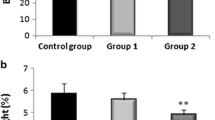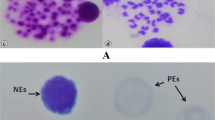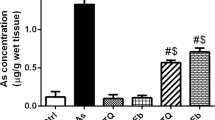Abstract
Thiamethoxam (TMX) is a non-mutagenic neonicotinoid insecticide that is widely used to combat different types of insects. The hepatotoxicity and carcinogenicity of TMX have been approved previously in mice but not in rats. However, the TMX-induced hepatotoxic and pro-carcinogenic effects on rabbits remain unclear. The present study elucidated the roles of oxidative stress, pro-inflammatory cytokines, and apoptosis-related genes in the hepatotoxic and carcinogenic effects of TMX on rabbits. Sixteen male rabbits were equally divided into two groups; eight rabbits orally treated with TMX at a dose of 250 mg/kg b.w for 90 successive days. Hepatotoxic effects of TMX were evidenced by attenuation of liver enzyme activities, elevation of bilirubin levels, and alterations in the hepatic architecture, including hepatocyte death by necrosis and apoptosis, lymphocyte infiltration and fibrosis. TMX induced oxidative stress, as evidenced by the significant increases in malondialdehyde levels and antioxidant enzyme (glutathione transferase and catalase) activities along with a decrease in glutathione levels. TMX also up-regulated the mRNA levels of interleukin-6 (1.6-fold) and B cell lymphoma-2 (1.8-fold) and down-regulated the mRNA level of the tumor necrosis factor-α (0.8-fold), indicating its effects on cell survival and proliferation through the inhibition of apoptosis. Interestingly, the elevated level of carcinoembryonic antigen and the appearance of ground glass-like hepatocytes suggested that TMX exerted a pro-carcinogenic effect. In conclusion, TMX exerts potentially hepatotoxic and pro-carcinogenic effects on rabbits by modulating oxidative/antioxidative status and pro-inflammatory cytokine production, inhibiting apoptosis and activating cell survival pathways.






Similar content being viewed by others
References
Abramoff MD, Magalhaes PJ, Ram SJ (2004) Image processing with ImageJ. Biophoton Int 11(7):36–42
Aleksandrova K, Boeing H, Nöthlings U, Jenab M, Fedirko V (2014) Inflammatory and metabolic biomarkers and risk of liver and biliary tract cancer. Hepatol 60(3):858–871. https://doi.org/10.1002/hep.27016
Ambali S, Akanbi D, Igbokwe N, Shittu M, Kawu M, Ayo J (2007) Evaluation of subchronic chlorpyrifos poisoning on hematological and serum biochemical changes in mice and protective effect of vitamin C. J Toxicol Sci 32(2):111–120. https://doi.org/10.2131/jts.32.111
An F, Gong B, Wang H, Yu D, Zhao G, Lin L, Tang W, Yu H, Bao S, Xie Q (2012) miR-15b and miR-16 regulate TNF mediated hepatocyte apoptosis via BCL2 in acute liver failure. Apoptosis 17(7):702–716. https://doi.org/10.1007/s10495-012-0704-7
Bancroft J. D., Stevens A(1992) Theory and practice of histological techniques, 3rd Edition, Churchill Livingstone. Edinburg, London, Melbourne and New York
Bannasch P (2012) Glycogenotic hepatocellular carcinoma with glycogen-ground-glass hepatocytes: a heuristically highly relevant phenotype. World J Gastroenterology 18(46):6701–6708. https://doi.org/10.3748/wjg.v18.i46.6701
Bayoumi AE, Garcia-Fernandez AJ, Ordonez C, Perez-Pertejo Y, Cubria JC, Reguera RM, Balana-Fouce R, Ordonez D (2001) Cyclodiene organochlorine insecticide induced alterations in the sulfur-redox cycle in CHO-K1 cells. Comp Biochem Physiol Part C 130:315–323
Bhardwaj S, Srivastava MK, Upasana K, Srivastava LP (2010) A 90 days oral toxicity of imidacloprid in female rats morphological, biochemical& histopathological evaluation. Food Chem Toxicol 48(5):1185–1190. https://doi.org/10.1016/j.fct.2010.02.009
Carmichael NG, Enzmann H, Pate I, Waechter F (1997) The significance of mouse liver tumor formation for carcinogenic risk assessment: results and conclusions from a survey of ten years of testing. Environ Health Perspect 105(11):1196–1203. https://doi.org/10.1289/ehp.971051196
Deviere J, Content J, Denys C, Vandenbussche P, Schandene L (1989) High interleukin-6 serum levels and increased production by leucocytes in alcoholic liver cirrhosis. Correlation with IgA serum levels and lymphokines production Clin Exp Immunol 77(2):221–225
Di Prisco G, Cavaliere V, Annoscia D, Varricchio P, Caprio E, Nazzi F, Gargiulo G, Pennacchio F (2013) Neonicotinoid clothianidin adversely affects insect immunity and promotes replication of a viral pathogen in honey bees. Proc Natl Acad Sci U S A 110(46):18466–18471. https://doi.org/10.1073/pnas.1314923110
Duzguner V, Erdogan S (2010) Acute oxidant and inflammatory effects of imidacloprid on the mammalian central nervous system and liver in rats. Pestic Biochem Physiol 97(1):13–18. https://doi.org/10.1016/j.pestbp.2009.11.008
Duzguner V, Erdogan S (2012) Chronic exposure to imidacloprid induces inflammation and oxidative stress in the liver & central nervous system of rats. Pestic Biochem Physiol 104(1):58–64. https://doi.org/10.1016/j.pestbp.2012.06.011
El Okle OS, Lebda MA, Tohamy HG (2016) Thiamethoxam-induced biochemical, hormonal and histological alterations in rats. Int J Toxicol Pharmacol Res 8:320–325
EPA (2003) Draft Final Guidelines for Carcinogen Risk Assessment. U.S. Environmental Protection Agency, Washington DC
Felix L, George F, Ross C (2012) Drug-induced hepatotoxicity, Springer science &business media. p681
Green T, Toghill A, Lee R, Waechter F, Weber E, Peffer R, Noakes J, Robinson M (2005) Thiamethoxam induced mouse liver tumors and their relevance to humans Part 2: species differences in response. Toxicol Sci 86(1):48–55. https://doi.org/10.1093/toxsci/kfi125
Habig W, Pabst MJ, Jacoby WB (1974) Glutathione S-transferase: the first step in mercapturic acid formation. J Biol Chem 249(22):7130–7139
Tsai H-W, Lin Y-J, Lin P-W, Wu H-C, Hsu K-H, Yen C-J, Chan S-H, Huang W (2011) A clustered ground-glass hepatocyte pattern represents a new prognostic marker for the recurrence of hepatocellular carcinoma after surgery. Cancer 117(13):2951–2960. https://doi.org/10.1002/cncr.25837
ILSI, Meek ME, Bucher JR, Cohen SM, Dellarco V, Hill RN, Lehman-McKeeman LD, Longfellow D, Pastoor T, Seed J, Patton DE (2003) A framework for human relevance analysis of information oncarcinogenic modes of action. Crit Rev Toxicol 33(6):591–653
Iwakiri Y (2015) Nitric oxide in liver fibrosis: the role of inducible nitric oxide synthase. Clin Mol Hepatol 21(4):319–325. https://doi.org/10.3350/cmh.2015.21.4.319
Johnson C, Han Y, Hughart N, McCarra J, Alpini G, Meng F (2012) Interleukin-6 and its receptor, key players in hepatobiliary inflammation and cancer. Transl Gastrointest Cancer 1(1):58–70. https://doi.org/10.3978/j.issn.2224-4778.2011.11.02
Jones SA, Scheller J, Rose-John S (2011) Therapeutic strategies for the clinical blockade of IL-6/gp130 signaling. J Clin Invest 121(9):3375–3383. https://doi.org/10.1172/JCI57158
Kakumu S, Shinagawa T, Ishikawa T, Yoshioka K, Wakita T (1993) Interleukin 6 production by peripheral blood mononuclear cells in patients with chronic hepatitis B virus infection and primary biliary cirrhosis. Gastroenterol Jpn 28(1):18–24
Kanbur M, Liman BC, Eraslan G, Altinordulu S (2008) Effects of cypermethrin, propetamphos, and combination involving cypermethrin and propetamphos on lipid peroxidation in mice. Environ Toxicol 23(4):473–479. https://doi.org/10.1002/tox.20360
Keller KA, Banks C (2006) Multidose general toxicology studies. In: Toxicological testing handbook, principles, applications and data interpretation. 2nd edition. Edited by David Jacobson-kram and Kit A. Keller.Informa Healthcare USA, Inc. p149
Knodell RG, Ishak KG, Black WC, Chen TS, Craig R, Kaplowitz N, Kiernan N (1981) Formulation and application of a numerical scoring system for assessing histological activity in asymptomatic chronic active hepatitis. Hepatology 1(5):431–435. https://doi.org/10.1002/hep.1840010511
Crookham J, Dapson R (1991) Hazardous chemicals in the histopathology laboratory, 2nd ED. Anatech
Loewenstein MS, Zamcheck N (1978) Carcinoembryonic antigen (CEA) levels in benign gastrointestinal disease states. Cancer 42(S3):1412–1418. https://doi.org/10.1002/1097-0142(197809)42:3+<1412::AID-CNCR2820420805>3.0.CO;2-8
Luck H. (1965) Catalase, in: H.U. Bergmeyer (Ed.), Methods in enzyme analysis, Verlag-Chemic, Weinheim/Bergstrasse. Germany, DOI: https://doi.org/10.1016/B978-0-12-395630-9.50158-4
Masserolli M, Caballero T, O’Valle F, Del Moral RMG, Perez-Milena A, DelMoral RG (2000) Automatic quantification of liver fibrosis: design and validation of a new image analysis method: comparison with semi-quantitative indexes of fibrosis. J Hepatol 32(3):453–464. https://doi.org/10.1016/S0168-8278(00)80397-9
Monteiro JC, Moreira MM, Pereira FE, de Oliveira LR, da Cunha EA, Leite JF, Castro E, Sousa F (1989) Plasma levels of alpha-fetoprotein and carcinoembryonic antigen in patients with malignant gastrointestinal tumors. Acta Medica Port 2(6):245–252
Ohkawa H, Ohishi M, Yagi K (1970) Assay for lipid peroxides in animal tissues by thiobarbituric acid reaction. Anal Biochem 95:351–358
Pastoor T, Rose P, Llyod S, Peffer R, Green T (2005) Case study: weight of evidence evaluation of the human health relevance of thiamethoxam-related mouse liver tumors. Toxicol Sci 86(1):56–60. https://doi.org/10.1093/toxsci/kfi126
Pearse AGE (1980) Histochemistry, theoretical and applied, 4th edn. Vol. 1. Preparative and optical technology. Edinburgh: Churchill-Livingstone
Perveen K, Rafique M, Rukhsana N, Khan N (2012) Comparison of body weight, absolute and relative weight of pituitary gland in carbimazole and carbimazole plus thyroxin treated male albino rats. Pak J Pharmacol 29:17–23
Portt L, Norman G, Clapp C, Greenwood M, Greenwood MT (2011) Anti-apoptosis and cell survival: a review. Biochim Biophys Acta (BBA) - Mol Cell Res 1813 (1:238–259
Pu YS, Hour TC, Chuang SE (2004) Interleukin-6 is responsible for drug resistance and anti-apoptotic effects in prostatic cancer cells. Prostat 60(2):120–129. https://doi.org/10.1002/pros.20057
Ramzi SC, Vinay K, Stanley R (1994) Pathologic basis of diseases, vol 5. WB Saunders Company, Philadelphia, p 86
Reed JC (1994) Bcl-2 and the regulation of programmed cell death. J. Cell Biol 124(1):1–6. https://doi.org/10.1083/jcb.124.1.1
Ribeiro S, Guilhermino L, Sousa JP, Soares AMVM (1999) Novel bioassay based on acetylcholinesterase and lactate dehydrogenase activities to evaluate the toxicity of chemicals to soil isopods. Ecotoxicol Environ Saf 44(3):287–293. https://doi.org/10.1006/eesa.1999.1837
Rodrigues KJ, Santana MB, Do Nascimento JL, Picanco-Diniz DL, Mauesl AL, Santos SN, Ferreira VM, Alfonso M, Duran R, Faro LR (2010) Behavioral and biochemical effects of neonicotinoid thiamethoxam on the cholinergic system in rats. Ecotoxicol Environ Saf 73(1):101–107. https://doi.org/10.1016/j.ecoenv.2009.04.021
Ruibal MA (1992) CEA serum levels in non-neoplastic disease. Int J Biol Markers 7(3):160–166
Salema LH, Alwan MJ, Yousif AA (2014) Antioxadative and antigenotoxic effects against cytotoxicity of thiamethoxam on mice. Int J Adv Res 2(10):507–511
SAS (2009) In: Cary (ed) Statistical Analysis System. Version 9. SAS Institute Inc
Sauer E, Moro AM, Natália B, Sabrina N, Bruna G, Rafael F, Adriana G, Ruy B, José CM, Vera LE, Solange CG (2014) Liver δ-aminolevulinate dehydratase activity is inhibited by neonicotinoids and restored by antioxidant agents. Int J Environ Res Public Health 11(11):11676–11690. https://doi.org/10.3390/ijerph111111676
Sedlak J, Lindsay RH (1968) Estimation of total, protein-bound, and nonprotein sulfhydryl groups in tissue with Ellman’s reagent. Anal Biochem 25(1):192–205. https://doi.org/10.1016/0003-2697(68)90092-4
Stoyanova S, Yancheva V, Iliev I, Vasileva T, Bivolarski V, Velcheva I, Georgieva E (2016) Biochemical, histological and histochemical changes in Aristichthys nobilis rich. Liver exposed to thiamethoxam. Period Biol 118(1):29–36. 10.18054/pb.2016.118.1.2828
Sun Y, Tokushige K, Isono E, Yamauchi K, Obata H (1992) Elevated serum interleukin-6 levels in patients with acute hepatitis. J Clin Immunol 12(3):197–200. https://doi.org/10.1007/BF00918089
Swenson TL, Casida JE (2013) Neonicotinoid formaldehyde generators: possible mechanism of mouse-specific hepatotoxicity/hepatocarcinogenicity of thiamethoxam. Toxicol Lett 216(2-3):139–145. https://doi.org/10.1016/j.toxlet.2012.11.027
Tokin IB, Tokin II, Filimonova GF (2011) Quantitative morphometric analysis of liver biopsy: problems and perspectives, liver biopsy, Dr Hirokazu Takahashi (Ed.). ISBN: 978-953-307-644-7, InTech, available from: http://www.intechopen.com/books/liver- biopsy/quantitative-morphometric-analysis-ofliver-biopsy-problems-and-perspectives
Tokin II, Tokin IB, Filimonova G, Hussar P (2012) Dynamics of cell population structure in liver biopsy of the patients with chronic hepatitis viral infection. Papers on Anthropology XXI: 276–286
Tomizawa M, Casida JE (2005) Neonicotinoid insecticide toxicology: mechanisms of selective action. Annu Rev Pharmacol Toxicol 45(1):247–268. https://doi.org/10.1146/annurev.pharmtox.45.120403.095930
Tylor BS, Alarcon LH, Billiar TR (1998) Inducible nitric oxide synthase in the liver: regulation and function. Biochemistry (Mosc) 63(7):766–781
Van Wagner LB, Green RM (2015) Evaluating elevated bilirubin levels in asymptomatic adults. J Am Med Assoc 313(5):516–517
Wang K (2014) Molecular mechanisms of hepatic apoptosis. Cell Death Dis 5(1):e996. https://doi.org/10.1038/cddis.2013.499
Wright SC, Zhong J, Larrick JW (1994) Inhibition of apoptosis as a mechanism of tumor promotion. FASEB J 8(9):654–660
Yan SH, Wang JH, Zhu LS, Chen AM, Wang J (2016) Thiamethoxam induces oxidative stress and antioxidant response in zebrafish (Danio Rerio) livers. Environ Toxicol 31(12):2006–2015. https://doi.org/10.1002/tox.22201
Yuan JS, Reed A, Chen F, Stewart CN (2006) Statistical analysis of real-time PCR data. BMC Bioinformatics 7(1):85. https://doi.org/10.1186/1471-2105-7-85
Author information
Authors and Affiliations
Corresponding author
Ethics declarations
All experimental procedures were performed in accordance with the National Institutes of Health (NIH) Guidelines for the Care and Use of Laboratory Animals, and the study protocol was approved by the ethics committee of the Faculty of Veterinary Medicine, Alexandria University, Egypt.
Conflict of interest
The authors declare that there is no conflict of interest.
Additional information
Responsible editor: Philippe Garrigues
Rights and permissions
About this article
Cite this article
El Okle, O.S., El Euony, O.I., Khafaga, A.F. et al. Thiamethoxam induced hepatotoxicity and pro-carcinogenicity in rabbits via motivation of oxidative stress, inflammation, and anti-apoptotic pathway. Environ Sci Pollut Res 25, 4678–4689 (2018). https://doi.org/10.1007/s11356-017-0850-0
Received:
Accepted:
Published:
Issue Date:
DOI: https://doi.org/10.1007/s11356-017-0850-0




